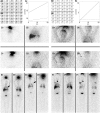Physiotherapeutic stimulation: Early prevention of lymphedema following axillary lymph node dissection for breast cancer treatment
- PMID: 23136607
- PMCID: PMC3490344
- DOI: 10.3892/etm_00000024
Physiotherapeutic stimulation: Early prevention of lymphedema following axillary lymph node dissection for breast cancer treatment
Abstract
The aim of this study was to confirm the effectiveness of early physiotherapeutic stimulation for lymphatic flow progression in patients with breast cancer undergoing axillary dissection. This was a randomized experimental study on 22 patients who underwent lymphoscintigraphy in their arms on two different occasions, firstly without stimulation and secondly after randomization into two groups: without physiotherapeutic stimulation (WOPS; n=10) and with physiotherapeutic stimulation (WPS; n=12). The lymphoscintigraphy scan was performed with (99m)Tc-phytate administered into the second interdigital space of the hand, ipsilaterally to the dissected axilla, in three phases: dynamic, static, and delayed whole body imaging. Physiotherapeutic stimulation was carried out using Földi's technique. In both groups, images from the two examinations of each patient were compared. Flow progression was considered positive when, on the second examination, the radiopharmaceutical reached areas more distant from the injection site. Statistical analysis was used to evaluate frequencies, percentages and central trend measurements, and non-parametric tests were conducted. Descriptive analysis showed that the WPS and WOPS groups were similar in terms of mean age, weight, height, body mass index and number of lymph nodes removed. There were statistically significant associations between physiotherapeutic stimulation and radiopharmaceutical progression at all three phases of the study (p<0.0001). Early physiotherapeutic stimulation in breast cancer patients undergoing radical axillary dissection is effective, and can therefore be indicated as a preventive measure against lymphedema.
Figures


References
-
- National Cancer Institute (NCI), USA Progress shown in death rates from four leading cancers: decline in overall mortality has slowed (monograph on the Internet) Available from: http://www.nci.nih.gov/newscenter/pressreleases/2003ReportRelease. Cited March 2004.
-
- Instituto Nacional do Câncer (INCA) 2008. Estimativa 2008: incidência de câncer no Brasil. INCA, Rio de Janeiro,
-
- Johansson S, Svensson H, Denekamp J. Dose response and latency for radiation-induced fibrosis, edema and neuropathy in breast cancer patients. Int J Radiot Oncol Biol Phys. 2002;52:1207–1219. - PubMed
-
- Bergmann A, Mattos IE, Koifman RJ. Diagnóstico do linfedema: análise dos métodos empregados na avaliação do membro superior após linfadenectomia axilar para tratamento do câncer de mama. Rev Bras Canc. 2004;50:311–320.
-
- Bourgeois P, Leduc O, Leduc A. Imaging techniques in the management and prevention of posttherapeutic upper limb edemas. Cancer. 1998;83:2805–2813. - PubMed
LinkOut - more resources
Full Text Sources
